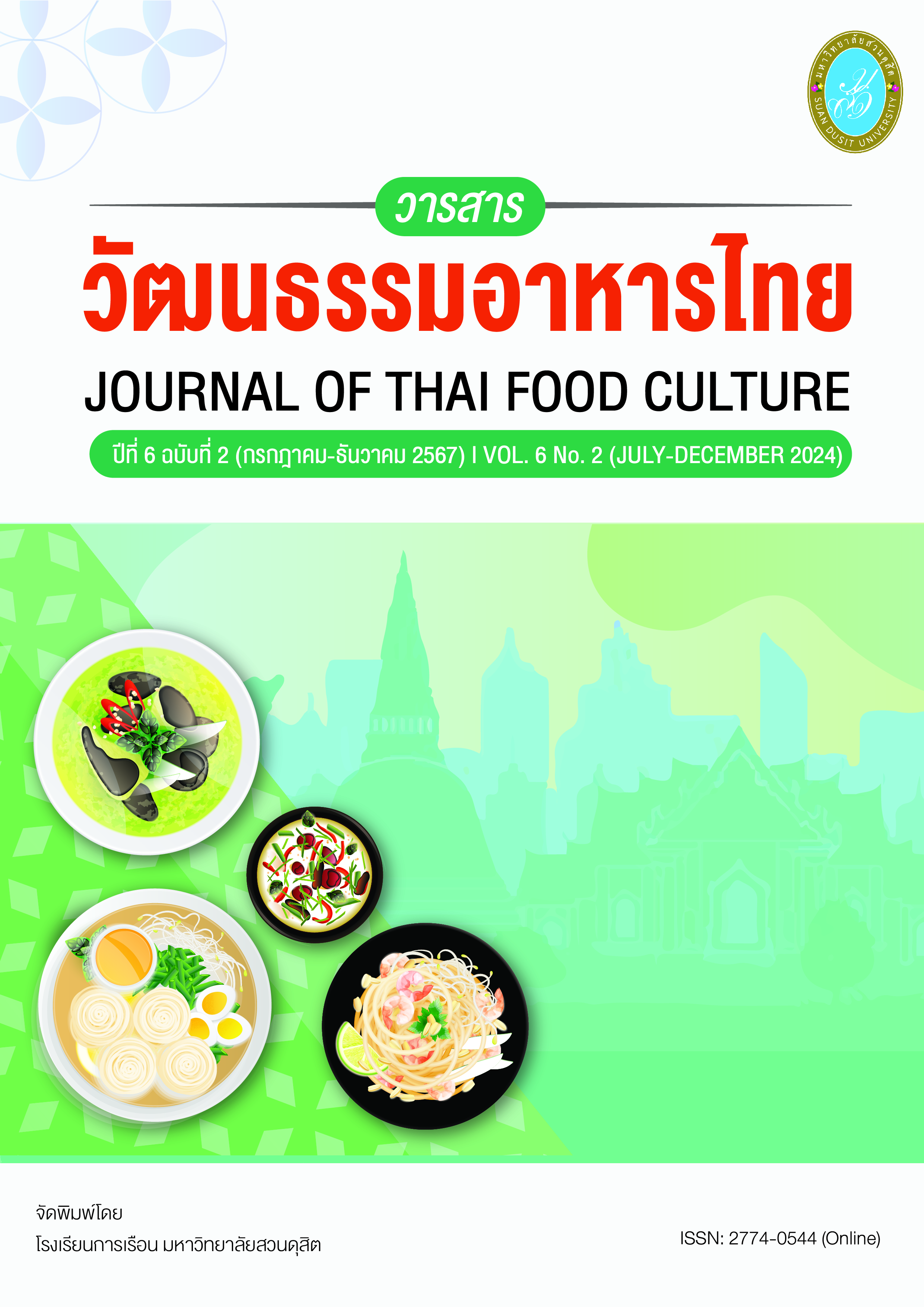Karanda fruit gummy made with carrageenan in combination with carboxymethylcellulose
Keywords:
Gummy, Karanda fruit, Carrageenan, CarboxylmethylcelluloseAbstract
Gummy jelly generally uses gelatin as a gelling agent, therefore vegetarians cannot consume this type of product. Therefore, alternative gelling agents are used in gummy candy. The carrageenan is a gelling agent produced from red algae and carboxymetylcellulose (CMC) which is derivative plant-based cellulose widely used in such products. Karanda fruits contain high nutritional value. It is a source of vitamin C and anthocyanin which are antioxidants. The objective of this research was to develop a Karanda gummy jelly from carrageenan at 2.43, 3.21, and 3.99% of the ingredient weight. Gelatin-based gummy jelly was used as a control sample. It was found that with the increasing of carrageenan, the color values aw hardness, cohesiveness, gumminess and springiness were increased. Gummy jelly with 3.21% carrageenan had the closest values of moisture content, L* b* and a* to the control formula that was selected to develop gummy jelly from carrageenan combination with CMC at 0.04, 0.08, and 0.12%. It was found that the gummy formula using carrageenan at 3.21% combination with 0.04% CMC has a quality most similar to gelatin gummies. Due to the moisture content, Adhesiveness, Cohesiveness, Springiness, Chewiness, brightness (L*), red (a*) and yellow (b*) values of sample are the closest to the control sample. This study can be used as a guideline gelatin-free gummy jelly product from carrageenan and carboxymethylcellulose.
References
กรมวิชาการเกษตร. 2543. เยลลี่มะม่วง. วารสารสถาบันอาหาร. 3(14): 41-42.
นราธิป ปุณเกษม. 2556. การพัฒนาผลิตภัณฑ์กัมมี่สมุนไพรไทยแคลลอรี่ต่ำ: ขิง. มหาวิทยาลัยราชภัฏสวนดุสิต, กรุงเทพฯ.
ภาสุรี ฤทธิเลิศ และกมลวรรณ วารินทร์. 2562. การพัฒนาผลิตภัณฑ์กัมมี่เยลลี่มะม่วงหาวมะนาวโห่. Thai Journal of Science and Technology. 9(2). 354-352.
มัทนา แสนจินดาวงษ์, วันชัย วรวัฒนเมธีกุล, วรรณวิมล คล้ายประดิษฐ์. 2552. การผลิตเจลาตินจากเศษเหลือของ กระบวนการผลิตซูริมิ. ใน:นิทรรศการงานวิจัย บนเส้นทางงานวิจัย มหาวิทยาลัยเกษตรศาสตร์ ในงานวันเกษตรแห่งชาติ ประจำปี 2552.
มธุรส รัตนวงศ์สนิท. 2562. การพัฒนาผลิตภัณฑ์การแปรรูปผลมะม่วงหาวมะนาวโห่ (Carissa carandas) ในระยะผลกึ่งสุกและระยะผลสุก. วิทยานิพนธ์ปริญญามหาบัณฑิต มหาวิทยาลัยราชภัฏวไลยอลงกรณ์ ในพระบรมราชูปถัมภ์.
ยุวดี ขุนภักดี, วรินทร กาวี, นพดล โพชกําเหนิด และณรงค์ สุนทรอภิรักษ์. 2555. เยลลี่คาราจีแนนผสมเนื้อลูกจากเพื่อชุมชน. วารสารมหาวิทยาลัยทักษิณ. 15(3)(พิเศษ): 230-231.
วชิราภรณ์ ผิวล่อง, สุรศักดิ์ สัจจบุตร, ศิริลักษณ์ สิงห์เพชร และจารุรัตน์ เอี่ยมศิริ. 2556. อิทธิพลของระยะเวลาสุกต่อสารออกฤทธิ์ทางชีวภาพของมะนาวโห่. วารสารวิทยาศาสตร์เกษตร 44: 337-340.
วิไล รังสาดทอง. เทคโนโลยีการแปรรูปอาหาร. พิมพ์ครั้งที่ 5 กรุงเทพฯ:เท็กซ์ แอนด์ เจอร์นัล, 2552.
สุวรรณา สุภิมารส. เทคโนโลยีการผลิตลูกกวาดและช็อกโกแลต. กรุงเทพฯ:สำนักพิมพ์แห่งจุฬาลงกรณ์มหาวิทยาลัย. 2543.
Ako, K. 2015. Influence of elasticity on the syneresis properties of K-carrageenan gels. Carbohydrate Polymers. 115: 408-414.
Dranca, I., & Vyazovkin, S. (2009). Thermal stability of gelatin gels: Effect of preparation conditions on the activation energy barrier to melting. Polymer, 50(20), 4859-4867.
Dunstan, D. E., Chen, Y., Liao, M. L., Salvatore, R., Boger, D. V., & Prica, M. (2001). Structure and rheology of the κ-carrageenan/locust bean gum gels. Food hydrocolloids, 15(4-6), 475-484.
Kreungngern, D. and Chaikham, P. (2016). Rheological physical and sensory attributes of Chao Kuay jelly added with gelling agents. International Food Research Journal. 23(4), 1474-1478.
Mattioli, R., Francioso, A., Mosca, L., & Silva, P. (2020). Anthocyanins: A Comprehensive Review of Their Chemical Properties and Health Effects on Cardiovascular and Neurodegenerative Diseases. Molecules (Basel, Switzerland), 25(17), 3809.
Popescu, C., Iordan, M., & Cristian, B. (2007). Structure and properties of carragenan. The Annals Valahia University of Tărgovişte, 27-32.
Rinaudo, M. (2007). Comprehensive Glycoscience. In Seaweed Polysaccharides. 2, 691–735.
Sinurat, E., Murdinah, and Utomo, B.S.B. (2006). Functional properties of mixed formula of Kappa and Lota carrageenan with other gums. Jurnal Pascapanen dan Bioteknologi Kelautan dan Perikanan, 1(1), 1-8.
Soedirga and Marchellin. (2022). Physicochemical Properties of Jelly Candy Made with Pectin from Red Dragon Fruit Peel in Combination with Carrageenan. Caraka Tani: Journal of Sustainable Agriculture, 37(1), 1-14.
Subaryono and Utomo, B,S,B. (2006). The use of carrageenan-conjac in jelly candy production. Jurnal Pascapanen dan Bioteknologi Kelautan dan Perikanan, 1(1), 19-26.
Tunieva, E. K., Spiridonov, K. I., & Nasonova, V. V. (2021). A study on the synergetic interaction of kappa-carrageenan with konjac gum. In IOP Conference Series: Earth and Environmental Science (Vol. 640, No. 5, p. 052012). IOP Publishing.
Utomo, B. S. B., Darmawan, M., Hakim, A. R., & Ardi, D. T. (2014). Physicochemical properties and sensory evaluation of jelly candy made from different ratio of k-carrageenan and konjac. Squalen Bulletin of Marine and Fisheries Postharvest and Biotechnology, 9(1), 25-34
Wu, D., Yu, S., Liang, H., He, C., Li, J., & Li, B. (2020). The influence of deacetylation degree of konjac glucomannan on rheological and gel properties of konjac glucomannan/κ-carrageenan mixed system. Food Hydrocolloids, 101, 105523.
Zhang, W., Liu, Y., Xuan, Y., & Zhang, S. (2022). Synthesis and applications of carboxymethyl cellulose hydrogels. Gels, 8(9), 529.
Zielinska, M., & Markowski, M. (2012). Color characteristics of carrots: effect of drying and rehydration. International Journal of Food Properties, 15(2), 450-466.
Downloads
Published
How to Cite
Issue
Section
License
Copyright (c) 2025 School of Culinary Arts, Suan Dusit University

This work is licensed under a Creative Commons Attribution-NonCommercial-NoDerivatives 4.0 International License.
ลิขสิทธิ์ต้นฉบับที่ได้รับการตีพิมพ์ในวารสารวัฒนธรรมอาหารไทย ถือเป็นกรรมสิทธิ์ของโรงเรียนการเรือน มหาวิทยาลัยสวนดุสิต ห้ามผู้ใดนำข้อความทั้งหมดหรือบางส่วนไปพิมพ์ซ้ำ เว้นแต่จะได้รับอนุญาตอย่างเป็นลายลักษณ์อักษรจากโรงเรียนการเรือน มหาวิทยาลัยสวนดุสิต นอกจากนี้ เนื้อหาที่ปรากฎในบทความเป็นความรับผิดชอบของผู้เขียน ทั้งนี้ไม่รวมความผิดพลาดอันเกิดจากเทคนิคการพิมพ์


